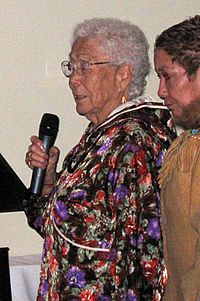Koyukon facts for kids

Poldine Carlo, Koyukon author, 2007
|
|
| Regions with significant populations | |
|---|---|
| United States (Alaska) | 2,300 |
| Languages | |
| English, Koyukon, Russian (historically) | |
| Religion | |
| Christianity, Animism | |
| Related ethnic groups | |
| Deg Hit'an, Gwich'in, other northern Athabaskan peoples | |
The Koyukon (Russian: Коюконы) are a group of Native people from Alaska. They are part of the larger Athabascan family. For thousands of years, their traditional home has been along the Koyukuk and Yukon rivers. They have always lived by hunting and trapping animals. Many Koyukon people still live this way today.
The Koyukon language is part of a big language family called Na-Dené or Athabaskan. Many native groups across northwestern North America traditionally speak these languages. Because people moved long ago, other Na-Dené languages are also spoken in the American Southwest and Mexico. These include languages like Navajo and Apachean varieties.
Contents
Koyukon History and First Encounters
The first Europeans to visit the Koyukon lands were Russians. They traveled up the Yukon River to Nulato in 1838. When the Russians arrived, they saw that the Koyukon people already had many European items. These included iron pots, glass beads, cloth, and tobacco. The Koyukon had traded with coastal Eskimo people to get these goods. The Eskimos had traded with Russians for a long time.
A terrible sickness called smallpox had reached the villages before the Russians. This disease caused many deaths among the Koyukon people. In the years that followed, more European diseases spread. The Koyukon people had no natural protection against these new sicknesses. This greatly reduced their population.
The Yukon Gold Rush and Its Impact
The Koyukuk River area remained mostly isolated until 1898. That year, the Yukon Gold Rush brought over a thousand men to the river. They were looking for gold. However, they found very little gold. Most of them left the area the following winter.

Scientists have found old tools and signs of life in the area. This archaeological evidence shows that the Koyukon people have lived in their region for at least 1,000 years. Their cultural roots in this land go back thousands of years even before that.
Plants Used by the Koyukon People
The Koyukon people use plants from their environment in many ways. For example, they freeze lingonberries to eat during the winter months.
Notable Koyukon Individuals
Many Koyukon people have made important contributions. Here are a few:
- Nikoosh Carlo, PhD, is a scientist and policy advisor. Dr. Carlo has advised the Governor of Alaska on climate and Arctic policy. He also worked for the U.S. Department of State.
- Poldine Carlo was a well-known writer and respected elder in the community.
- Kathleen Carlo-Kendall is a talented professional carver and artist.
- Mary Jane Fate was an important activist and leader for her people.
- Walter Harper was the first person known to reach the top of Denali (Mount McKinley). He achieved this in June 1913.
- Emil Notti is an American engineer, a Native activist, and a Democratic politician.
- Michael J. Stickman was the First Chief of the Nuwato Tribal Council.
- Morris Thompson was a successful businessman and leader.
See also
 In Spanish: Koyukón para niños
In Spanish: Koyukón para niños

